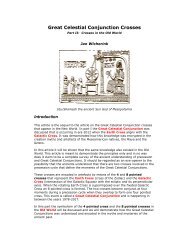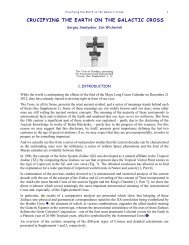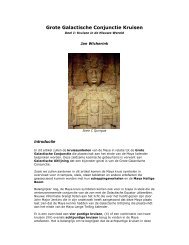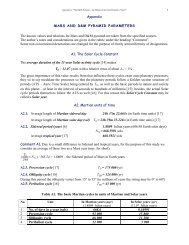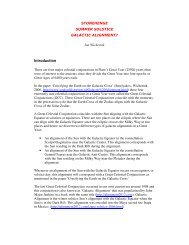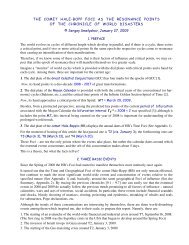THE D&M PYRAMID OF CYDONIA â THE ... - Souls of Distortion
THE D&M PYRAMID OF CYDONIA â THE ... - Souls of Distortion
THE D&M PYRAMID OF CYDONIA â THE ... - Souls of Distortion
You also want an ePaper? Increase the reach of your titles
YUMPU automatically turns print PDFs into web optimized ePapers that Google loves.
The D&M Pyramid – the Sibling <strong>of</strong> the Great Pyramid <strong>of</strong> Giza? 14<br />
C2. The areas <strong>of</strong> the D&M faces the bases <strong>of</strong> which correspond to the regular pentagon are equal just<br />
when the Pyramid apex is placed at the specific height, and this height corresponds to the existing<br />
estimate <strong>of</strong> the altitude <strong>of</strong> the D&M Pyramid. At this, the ratio r z <strong>of</strong> the areas corresponding to the<br />
Φ<br />
pentagonal and hexagonal faces is expressed through the same primal constants r Z ≅ ( δ = 0.1%)<br />
.<br />
e π<br />
D&M’s vs. GP’s Latitudes<br />
Hoagland discovered that the geodetic Martian latitude L DM = Arc tan e π<br />
= 40.8681938… almost<br />
exactly passes through the D&M Pyramid. Amazingly, another trigonometrical function – Arc cosine <strong>of</strong><br />
the same ratio – gives the latitude <strong>of</strong> the Great Pyramid <strong>of</strong> Giza L = Arc cos e = 30.08805…[12]<br />
C3. Within the accepted accuracy the floor plan <strong>of</strong> the D&M pyramid taken as a cross-section <strong>of</strong> the<br />
Globe in a similar geometrical approach defines the co-ordinated latitudes <strong>of</strong> the Greatest Pyramids on<br />
the Earth (14) and Mars (15), alongside with the latitude (16) equal to N , or Tetrahedral Constant.<br />
GP<br />
G<br />
π<br />
D&M’s vs. GP’s Side Lengths<br />
C4. The basic dimension <strong>of</strong> the D&M pyramid – the length a <strong>of</strong> the sides <strong>of</strong> the equilateral triangles –<br />
virtually coincides with the Terrestrial geographical mile, that is with the length <strong>of</strong> 1 arc min <strong>of</strong> Earth’s<br />
Equator.<br />
C5. The primal linear parameter <strong>of</strong> the D&M pyramid – the side a – makes twice the perimeter <strong>of</strong> the<br />
Great Pyramid <strong>of</strong> Giza, or 8 times the length <strong>of</strong> its side.<br />
Amazingly, but the Egyptian cubit also plays an important part in these correlations:<br />
C6. Within the source data accuracy the perimeter <strong>of</strong> the D&M pyramid in Egyptian cubits makes the<br />
number <strong>of</strong> arc minutes in a circle, N = 21600 (viz. 360× 60’)<br />
m<br />
D&M vs. Mars Dimensions<br />
C7. In Martian Equatorial miles [A3], or arc minutes, the length <strong>of</strong> the side a is also expressed in the<br />
Φ<br />
DM constants, a E ≅<br />
e π<br />
( δ = 0.01 %) and coincides with the ratio <strong>of</strong> areas <strong>of</strong> the pentagon and<br />
hexagon related faces.<br />
C8. Moreover, by dividing the length <strong>of</strong> Equator (in arc minutes) by the length <strong>of</strong> side a E (in the same<br />
units) we obtain TPH<br />
= 11551. Within the accepted tolerance this value presents half <strong>of</strong> the Perihelion<br />
cycle <strong>of</strong> 22 900 Martian years [Table A1].<br />
To this end it is important to note that, in contrast to Earth, this cycle is evidently more pronounced for<br />
Mars than the cycle <strong>of</strong> precession (93 000 Martian years) due to its duration and significant difference in<br />
Aphelion/Perihelion distances [6]<br />
C9. In D&M-latitudinal miles [A3] (or D&M-latitudinal arc minutes) the length a DM <strong>of</strong> the side a<br />
coincides with the D&M base area S (See Table 1), its approximant and also exactly approximated by<br />
4 ϕ ( δ = 0.006 %).





